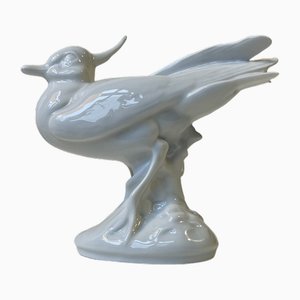
The Royal Copenhagen brand was founded as the Royal Danish Porcelain Manufactory in 1775 by chemist Frantz Heinrich Müller (1738-1820), under the protection of Denmark’s Queen Juliane Marie. Like all monarch-sponsored porcelain workshops initiated in countries around Europe in the 18th century (e.g. Meissen, Sèvres, Wedgewood), Royal Copenhagen products were intended to compete in the market for expertly crafted Chinese imports, which were wildly popular among European aristocracy at the time. When Müller discovered a Danish source for kaolin, the crucial ingredient in fine, hard-paste porcelain, the Queen seized the opportunity to contribute to her local economy (as well as her international status) and awarded Müller a 50-year monopoly on porcelain production in Denmark.
Royal Copenhagen’s signature Blue Fluted pattern—the cobalt blue-on-white scrolling floral motif—was developed from the outset under Müller’s direction to imitate the stylized chrysanthemums found on Chinese imports, as well as the look of Meissen porcelain (the first true porcelain produced in Europe). This collection and its variants continue to be the brand’s bestseller today. Other iconic works from Royal Copenhagen’s production include the Flora Danica service (1790-1803), which feature polychrome plants and flowers inspired by the botanical encyclopedia of the same name and originally made for Catherine II of Russia; and, more recently, the modernist Blue Line dinnerware collection developed by architect-designer Grethe Meyer in 1965.
In nearly 250 years, the Royal Copenhagen brand has produced over 1,500 pattern variations on high-quality porcelain and faience cups, mugs, jugs, bowls, plates, tea sets, and more, typically employing highly skilled artisans and, since the 20th century, collaborating with talented designers. The production procedure for each piece has evolved since the early days, but it still takes a few months to complete each set. The process starts with a delicate model produced by a 3D printer and then perfected by hand. This first sculpture is then used to make the final mold by a computerized milling machine; a porcelain liquid is then carefully poured into this and embellished with handles and decorations. Lastly, the unique artwork is hand-painted before it is glazed and fired at nearly 1375°C.
Over time, Royal Copenhagen has passed hands from succeeding Danish sovereigns to the Aluminia faience company in 1882, and later in the 20th century incorporating with other Danish applied arts specialists like Georg Jensen, Holmegaard Glassworks, and Bing & Grøndahl. It’s now a subsidiary of Fiskars. The brand’s identifying stamps have also changed over time, but have consistently included three elements: three wavy lines symbolizing the Øresund, the Great Belt, and the Little Belt waterways in Denmark, the crown emblem representing the traditional royal patronage, and the individual artist’s signature marks.

